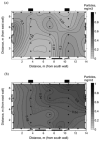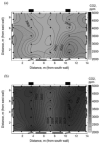Wintertime factors affecting contaminant distribution in a swine farrowing room
- PMID: 23548103
- PMCID: PMC4753562
- DOI: 10.1080/15459624.2013.777303
Wintertime factors affecting contaminant distribution in a swine farrowing room
Abstract
An estimated 200,000 to 500,000 U.S. workers in concentrated animal feeding operations (CAFOs) are at risk of adverse respiratory outcomes from exposures to indoor contaminants. In the wintertime, general ventilation is minimized in the Midwest due to high heating costs required to maintain indoor temperatures optimal for animal production. Pit fans typically operate to exhaust under-floor manure pits, but little other fresh air intake exists. Many operators believe that these systems are sufficient to reduce contaminant concentrations within the building during winter. Investigating whether these pit fans provide sufficient protection against classic CAFO contaminants during minimal wintertime ventilation was warranted. Direct-reading instruments were used to measure and record concentrations of multiple contaminants using both fixed-area and mobile contaminant mapping in a farrowing room during a Midwest winter. With the exception of CO, concentrations were significantly (p<0.001) higher with the pit fan off compared with those with the pit fan on. Additional analyses identified that significant changes (p<0.001) in mean room concentrations of respirable dust (decreased, 77% with pit fan off and 87% with pit fan on) and CO2 (increased, 24%) over the 5-hr study periods and that multiple fixed-area monitors rather than the much-used, single center-of-room monitor provided a more conservative (e.g., protective) assessment of room concentrations. While concentrations did not exceed occupational exposure limits from OSHA or ACGIH for individual contaminants, recommended agricultural health limits from exposure-response studies suggested in the literature were exceeded for respirable dust, CO2, and NH3, indicating a need to consider personal exposures and control options to reduce contaminant concentrations in farrowing rooms. Pit fans reduced NH3 and H2S concentrations, but these fans may not be sufficient to control dust and eliminate the need for secondary exposure prevention methods.
Figures



Similar articles
-
Use of prototype side stream filtration system to control dust levels in a commercial swine farrowing building.J Occup Environ Hyg. 2023 Dec;20(12):633-645. doi: 10.1080/15459624.2023.2247457. Epub 2023 Aug 15. J Occup Environ Hyg. 2023. PMID: 37582250 Free PMC article.
-
Use of Recirculating Ventilation With Dust Filtration to Improve Wintertime Air Quality in a Swine Farrowing Room.J Occup Environ Hyg. 2015;12(9):635-46. doi: 10.1080/15459624.2015.1029616. J Occup Environ Hyg. 2015. PMID: 25950713 Free PMC article.
-
Modeled effectiveness of ventilation with contaminant control devices on indoor air quality in a swine farrowing facility.J Occup Environ Hyg. 2014;11(7):434-49. doi: 10.1080/15459624.2013.875186. J Occup Environ Hyg. 2014. PMID: 24433305 Free PMC article.
-
Quartz exposure in agriculture: literature review and South African survey.Ann Occup Hyg. 2010 Apr;54(3):281-92. doi: 10.1093/annhyg/meq003. Epub 2010 Feb 19. Ann Occup Hyg. 2010. PMID: 20172918 Review.
-
Buildings operations and ETS exposure.Environ Health Perspect. 1999 May;107 Suppl 2(Suppl 2):313-7. doi: 10.1289/ehp.99107s2313. Environ Health Perspect. 1999. PMID: 10375293 Free PMC article. Review.
Cited by
-
Assessment of Interventions to Improve Air Quality in a Livestock Building.J Agric Saf Health. 2017 Nov 20;23(4):247-263. doi: 10.13031/jash.12426. J Agric Saf Health. 2017. PMID: 29140643 Free PMC article.
-
Evaluation of Low-Cost Hydrogen Sulfide Monitors for Use in Livestock Production.J Agric Saf Health. 2017 Nov 20;23(4):265-279. doi: 10.13031/jash.12530. J Agric Saf Health. 2017. PMID: 29140644 Free PMC article.
-
Simulation of air quality and cost to ventilate swine farrowing facilities in winter.Comput Electron Agric. 2013 Oct;98:136-145. doi: 10.1016/j.compag.2013.08.003. Epub 2013 Aug 30. Comput Electron Agric. 2013. PMID: 26937062 Free PMC article.
-
Use of prototype side stream filtration system to control dust levels in a commercial swine farrowing building.J Occup Environ Hyg. 2023 Dec;20(12):633-645. doi: 10.1080/15459624.2023.2247457. Epub 2023 Aug 15. J Occup Environ Hyg. 2023. PMID: 37582250 Free PMC article.
-
Simulation of air quality and operational cost to ventilate swine farrowing facilities in Midwest U.S. during winter.Trans ASABE. 2017;60(2):465-477. doi: 10.13031/trans.11784. Trans ASABE. 2017. PMID: 28775911 Free PMC article.
References
-
- U.S. Department of Agriculture (USDA) Swine 2006, Part IV: Changes in the US Pork Industry, 1990–2006. Fort Collins, Colo: USDA-APHIS-VS, CEAH; 2008. #N520.1108.
-
- Cormier Y, Boulet L, Bedard G, Tremblay G. Respiratory health of workers exposed to swine confinement buildings only or to both swine confinement buildings and dairy barns. Scand J Work Environ Health. 1991;17:269–275. - PubMed
-
- Donham KJ, Reynolds SJ, Whitten P, Merchant JA, Burmeister L, Popendorf WJ. Respiratory dysfunction in swine production facility workers: Dose-response relationships of environmental exposures and pulmonary function. Am J Ind Med. 1995;27(3):405–418. - PubMed
-
- Larsson K, Eklund A, Malmberg P, Belin L. Alterations in bronchoalveolar lavage fluid but not in lung function and bronchial responsiveness in swine confinement workers. Chest. 1992;101:767–774. - PubMed
-
- Iversen M, Dahl R. Working in swine-confinement buildings causes an accelerated decline in FEV1: A 7-yr follow-up of Danish farmers. Eur Respir J. 2000;16(3):404–408. - PubMed
Publication types
MeSH terms
Substances
Grants and funding
LinkOut - more resources
Full Text Sources
Other Literature Sources
Medical
